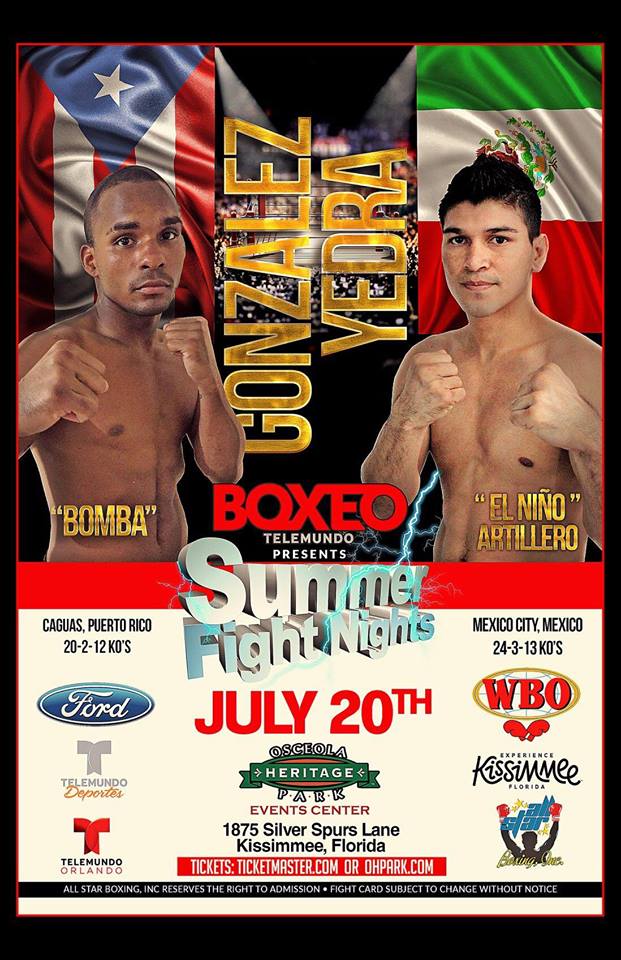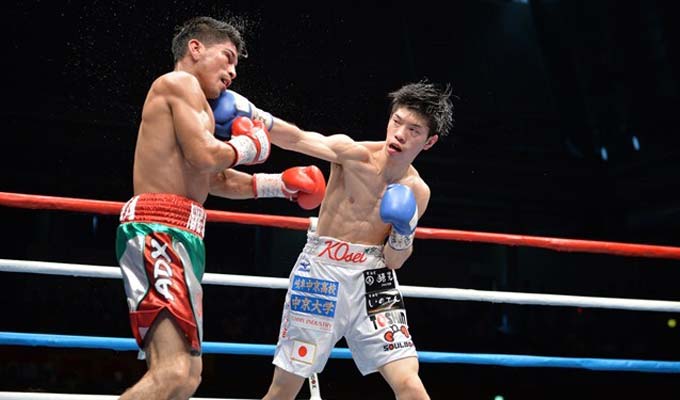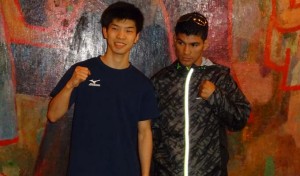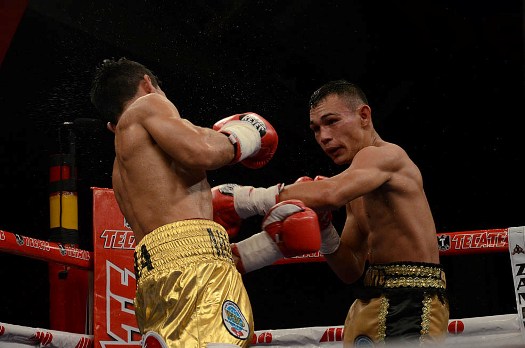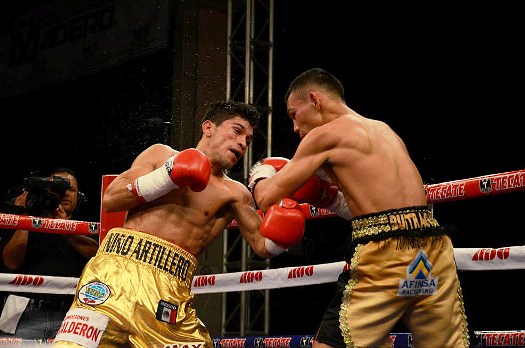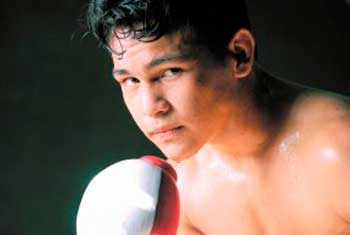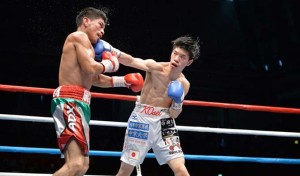
By Joe Koizumi
Photos by Boxing Beat
19-year-old unbeaten Japanese, Kosei Tanaka (5-0, 2 KOs), 105, very impressively acquired the vacant WBO 105-pound belt as he kept outspeeding and outpunching Mexican Julian Yedras (24-2, 13 KOs), 105, to win a unanimous decision over twelve fast rounds on Saturday in Komaki, Japan.
The official tallies read: Salven Lagumbay (Philippines) and Sawang Thaweekoon (Thailand) both 117-111, and Luis Ruiz (Puerto Rico) 115-113, all in favor of Tanaka, who thus won the world throne in his fifth pro bout. The referee was Samuel Viruet (US) who also moved so well as the busy-moving contestants. Tanaka, whose amateur mark was 46-5, 18 stoppages, displayed fast jabs, quick combinations and effective left hooks, and maintained the initiative despite the game Mexican’s occasional retaliation. Tanaka proved a real thing with such a fine performance as he looked like a young and small Sugar Ray Leonard.
Tanaka, an sophomore of Chukyo University, appeared sophomoric, utilizing various skills against the more experienced but one-dimensional Mexican such as shifty footwork, sharp flicker-jabbing, looping or short left hooking, well-timed countering and occasional infighting. Tanaka, much more skillful than Yedras, was an enfant terrible. The reporter hesitates to abuse a word of “genius” since, if doing so, there are so many geniuses here in Japan as three-class world champ Hiroki Ioka, two-time titlist Naoya Inoue, etc. But Tanaka is more than a vastly talented youngster by winning the crowd’s applause not only with his coronation but with his spectacular performance.
We, in Japan, now see nine world champions excluding Japan-based foreign titleholders such as Jorge Linares, but, only in terms of hand speed, Tanaka might be one of the best as he displayed lightening combinations to the game but slower Mexican, who said after the fight, “Tanaka was very fast and was too elusive with his lateral movement for me to catch up with. The chico (young kid) was splendid on speed, power and heart. I’m happy to have fought such a good boxer.” It is truly rare to hear such a straightforward admiration on a winner from a loser.
Tanaka, from the outset, showed his superior speed as he threw whiplash jabs and left-right combinations to the still cautious Mexican hombre. His mobility was reminiscent of Muhammad Ali in his rematch with Ken Norton. The second round witnessed the Japanese boy penetrate Yedras’ tight guard with a solid left-right combo to have him reeling to the ropes.
It was Tanaka that swept the first three rounds with a fine display of remarkable hand speed with good precision and power. Some 4,500 supporters in attendance at Park Arena Komaki were worried about his proper distribution of stamina, as he appeared to have started fireworks by consuming too much energy at the earlier stage.
As expected from his too hot opening attack, Tanaka’s vaunted footwork temporarily stopped midway in round four, when the shorter Mexican came forward and came close to him with a flurry of punches even on the block of the Japanese youngster, who recklessly responded to his rallies in the close range. It’s Yedras’ round.
Tanaka, however, won back the fifth session as he very furiously retaliated with a two-fisted attack, but seemingly spent too much energy—as if it had been a six-round competition—just to win a point even though his countering right uppercut had the knees almost buckled. The kid often caught the onrushing Mexican puncher with looping left hooks to the temple that apparently hurt Yedras, who nonetheless kept stalking the footworker.
Tanaka, in round six, recklessly mixed it up in the close quarter and Yedras maintained the pressure with incessant short punches to the face and to the midsection, while the youngster attempted to swap punches toe-to-toe with him without using his feet. Yedras was apparently in command. The crowd was afraid that the tide had turned then and there, and Yedras would take back the initiative from then onward.
It was, however, in the seventh that Tanaka showed his best as he courageously attacked the Mexican willing mixer with much faster combinations upstairs and downstairs. His jabs and one-two-left hook combinations were all effective enough to hurt the Mexican, who still refused to go down and tried to fight back with his best effort. It was a very furious round, which might be a good candidate of Round of the Year.
When Yedras returned to his corner, we saw he had the right cheek badly swollen with a lump due to his absorption of punishment. But he looked still mentally strong and willing to fight on.
The eighth was also hard-fought by the aggressive contestants, who exchanged hot rallies. Tanaka, with better precision, had the upper hand and almost stunned Yedras with a strong left-right combination. The Mexican warrior, however, landed a vicious right counter that shook up the Japanese prospect. Two judges favored Tanaka, while one gave a point to Yedras.
After the eighth round was over, the Tanaka adherents realized that there would be still no less than four more rounds though he had already consumed too much stamina due to his feverishly high pace. The worriers might be expecting Tanaka would be slowing down and Yedras would catch him with solid body shots as his Mexican cornermen incessantly kept yelling, “Abajo (downstairs)!”.
This reporter hereby becomes a Peeping Tom onto the interim scoresheet, though the open scoring system wasn’t applied to this bout. That’s 79-73, 78-74 and 77-75 in favor of Tanaka.
Amazingly did Tanaka turn loose in the ninth and keep punching almost entirely for three minutes. Where’s his energy from? From his youth? Yedras, of course, fought back hard but Tanaka’s faster combinations and hit-and-run tactics kept him from catching the busy and elusive target. Tanaka seemingly welcomed a second wind, as he accelerated freely punching and moving without feeling any fatigue.
Then we realized that Tanaka, a 19-year-young kid, wasn’t a Bernard Hopkins or a Japanese baseball player working in the US, Ichiro Suzuki, both of whom are 41 years of age. Kosei’s storage of abundant stamina was so astounding that the partisan crowd then expected Tanaka would maintain such a high pace and win the game.
Then tenth was spectacular enough since Tanaka’s footwork prevailed as fast as in the first three rounds and he served as a Sugar Ray Leonard in playing tag in a game of children. Busily jabbing and circling around the flat-footed Mexican, who was still aggressive and willing to mix it up, Tanaka finely displayed hit-and-run tactics to impress the crowd.
The eleventh witnessed Tanaka become a typical speedster, throwing flashy hand punches very fast but without putting his weight behind punches. He looked to have dominated this round only with his hand speed, and two judges gave this round to Tanaka, while another to Yedras who threw power punches even with low precision.
“With three more minutes you’ll be champion,” cried his chief second and father Hitoshi to encourage his son. Tanaka furiously commenced the final session with all his energy, as Yedras did. It’s a total war with the game warriors. It’s Tanaka that whipped Yedras from all angles so furiously as if he would finish him to bring home the bacon. But his too furious last surge had Tanaka slowing down in the last thirty seconds, when Yedras was courageous enough to fight back with his heart. When the final bell sounded, people really appreciated the good game from the bottom of heart.
After the official verdict announced his coronation Tanaka jubilantly said in the ring, “I’ve arrived at this place I had been aiming at for a long time since my childhood. I really thank for your people’s continually warm supports.”
Kosei Tanaka had a unique career. His father Hitoshi used to be a black belt of judo and Japanese national arm wrestling champion. He made his son learn karate at the age of three with his elder brother by two years, Ryosei, a student of Komazawa University, who is still amateur and national titlist for four years in a row. Kosei, when twelve, started learning how to box from his father, who has kept coaching his son since. Tanaka family was like Danny Garcia’s though Hitoshi isn’t as eloquent as Danny’s dad Angel.
To make a long story short, Kosei acquired national high school championship four times and turned professional under the tutelage of Kiyoshi Hatanaka, the first world champ ever produced in Nagoya area.
Tanaka, in November 2013, successfully made a pro debut by defeating WBO#6 Oscar Reknafa by a lopsided 6-round decision in Nagoya. Nicknamed “Knockout Dream Boy”, Kosei won a unanimous nod over WBA#13 Ronelle Ferreras in March 2014. His third bout saw a first-round knockout over OPBF#3 ranked Philippine champ Crison Omayao in July 2014. Tanaka, as the mandatory challenger, had an ambitious shot at WBO#2 OPBF 105-pound titlist and impressively dethroned him via tenth round TKO in October of the previous year. Literally that’s all as for his pre-history of coronation.
Chukyo University has produced many excellent young athletes such as Koji Murofuse (Olympic gold medalist in the shot put), Mao Asada (Olympic silver medalist in the figure skating), etc. Kosei Tanaka is one of those who have raised the Alma Mater’s reputation. Kosei is a little different from other boxers dependent on blood and guts since he often describes himself as a thinking boxer.
His manager/promoter Kiyoshi Hatanaka’s overall record was 25-2-1, 15 KOs, as he only suffered a couple of setbacks at the hand of as many Mexicans—Gilberto Roman and Daniel Zaragoza—each with a world championship at stake in 1988 and 1991 respectively. Tanaka avenged his manager’s setbacks to the Mexicans with his impressive victory.
Leon Panoncillo, the WBO supervisor, said, “Tanaka is the pride of our organization. He’s much better than we had expected. We hope he will grow up to be multiple-class champion since he is really talented. I love his tremendous hand speed in combination punching and his strong heart as well.”
The third man Samuel Viruet expressed his impression on the newly crowned champ, saying, “Tanaka boxed like a Bruce Lee, feinting, jabbing and shuffling. It’s fun watching him fight like that as the third man.”
This reporter hereby has to amend the list of “World Champions in Fewest Fights” that was previously compiled by historian Bob Yalen and yours truly by adding the Knockout Dream Boy.
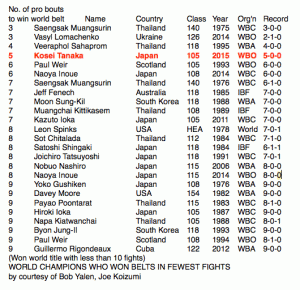
Tanaka always writes an autograph of “KOsei” which means, in Japanese, “Do Knockout!” This is just for your reference.
Tanaka became the fourth of the youngest world champions out of Japan, as shown by an attached list.

Tanaka is also the fifth world titlist ever produced from Nagoya area in Japan.

In the end, this record-keeper hereby lists up our current world champions in Japan.
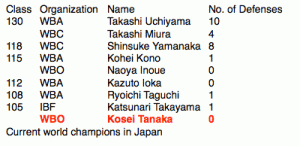
There are more episodes on Kosei Tanaka’s coronation, but should this reporter write them all, this writing wouldn’t finish within days. We just say we have had another good champion here in Japan.
Promoter: Hatanaka Promotions.
WBO supervisor: Leon Panoncillo (US).
http://www.fightnews.com/Boxing/full-report-tanaka-wins-wbo-title-in-5th-pro-bout-293074
